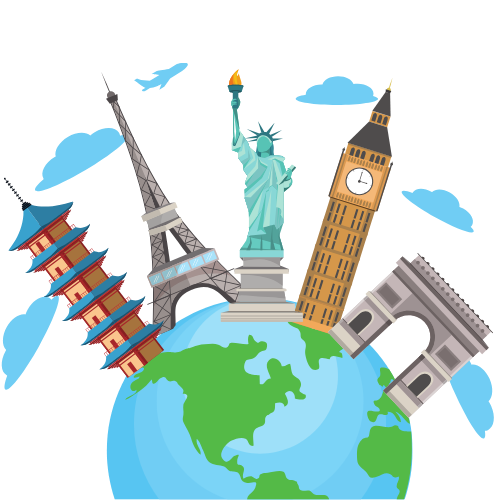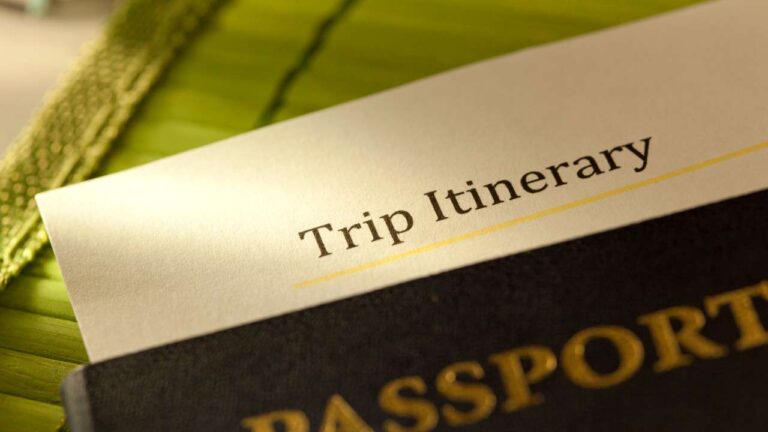Writing a travel itinerary is like crafting a roadmap for your journey. It’s about finding a balance between exploring new places, engaging in activities, and allowing yourself the freedom to experience the unexpected. For a 2-week trip, you want to ensure that everything flows smoothly without feeling too rushed or overly structured. An itinerary helps you allocate time efficiently, reduces the chances of missing out on key experiences, and leaves room for spontaneity.
Whether you’re backpacking through Europe, exploring Southeast Asia, or discovering hidden gems in your own country, this guide will equip you with the essential steps for creating a travel itinerary that fits your interests, pace, and budget.
Step 1: Define Your Travel Goals
Before jumping into the planning process, it’s crucial to define what you want to achieve with your trip. Every traveler has different goals, and understanding yours will help you tailor the itinerary accordingly.
Questions to ask yourself:
- What type of traveler are you? (Adventure seeker, cultural explorer, nature lover, foodie, etc.)
- What do you want to experience during your trip? (Historical sites, beach relaxation, nightlife, nature hikes, etc.)
- Are you more interested in city life or rural escapes?
- How fast or slow do you prefer to travel?
- What are your must-see destinations?
Once you’ve outlined your travel goals, you’ll have a better idea of how to structure your days. For instance, if you’re a history enthusiast, you may want to spend more time in cities with rich historical backgrounds. If you prefer relaxation, you might focus more on beach destinations or spa resorts.
Step 2: Research Your Destinations
Research is the backbone of a great itinerary. Spend time understanding the destinations you want to visit, what each place has to offer, and what activities or landmarks are of interest to you.
Key points to research:
- Popular attractions and hidden gems
- Local culture, traditions, and festivals
- Weather and best time to visit
- Local cuisine and dining options
- Entry requirements, visas, and travel restrictions
- Local transportation and commuting options
- Safety tips and emergency contacts
Tools for research:
- Travel blogs and websites (like Lonely Planet, TripAdvisor, or your own website TravelBucket!)
- Social media platforms such as Instagram and Pinterest
- YouTube travel vlogs for a virtual tour
- Guidebooks and travel apps
- Forums such as Reddit or Facebook travel groups
Once you’ve gathered all the necessary information, prioritize the destinations based on your travel goals and preferences. This research will help you decide how many days to spend in each place and which activities to schedule.
Step 3: Create a Rough Outline for the Trip
After researching the destinations, start creating a rough outline for your 2-week trip. This will serve as the skeleton of your itinerary, which you’ll refine as you move through the planning process.
Tips for creating a rough outline:
- Break the trip into days and assign each day to a specific destination.
- Plan for 2-4 days in major cities or regions, depending on how much there is to explore.
- Consider travel time between destinations and how it will affect your schedule.
- Include a mix of fast-paced exploration days and slower days for rest and relaxation.
For example:
- Day 1-3: City A – Sightseeing, local food, and cultural experiences.
- Day 4-6: City B – Outdoor activities, hiking, or beach time.
- Day 7-8: Travel to City C – Allocate time for traveling and relaxing after the journey.
- Day 9-11: City C – Explore key landmarks, enjoy the nightlife, or take day trips.
- Day 12-14: City D – Relax and reflect, indulge in a final local experience or shopping.
This rough draft gives you a high-level view of your trip and helps ensure you don’t cram too much into one day.
Step 4: Organize Day-by-Day Activities
Now it’s time to zoom in on the details. For each day of your 2-week itinerary, organize the specific activities you want to do. Balance must-see attractions with time for exploration and leisure. Be mindful not to overload your schedule—allow time to enjoy each place.
How to organize daily activities:
- Group activities based on location to minimize commuting.
- Start the day with top priorities when you have the most energy.
- Include smaller, secondary activities for the afternoons or evenings.
- Research opening hours, availability of tours, and any necessary bookings.
- Consider time for meals, especially if you plan to experience local cuisines at famous spots.
Sample daily itinerary:
- Day 5: City B Exploration
- 8:00 AM: Breakfast at a local café.
- 9:00 AM: Visit the famous landmark (Book in advance if necessary).
- 12:00 PM: Lunch at a traditional restaurant.
- 1:00 PM: Explore the local markets.
- 3:00 PM: Take a guided tour of the nearby historic site.
- 6:00 PM: Relax at a rooftop bar and enjoy the sunset.
- 8:00 PM: Dinner at a popular local restaurant.
This format ensures a well-balanced day, combining structured activities with opportunities for flexibility.
Step 5: Plan Your Accommodations
Where you stay can significantly impact your travel experience, so choosing the right accommodations is essential. Consider factors like proximity to attractions, transportation options, safety, and your travel budget.
Tips for choosing accommodations:
- Book accommodations in central locations to reduce travel time.
- Opt for hotels or rentals that offer early check-in or luggage storage.
- Look for reviews from other travelers to ensure safety and cleanliness.
- Consider staying at unique accommodations like boutique hotels, hostels, or Airbnb for a more local experience.
- The balance between luxury stays and budget-friendly options.
Key types of accommodations:
- Hotels: Best for convenience and services.
- Hostels: Great for budget travelers and meeting new people.
- Airbnb/Short-term rentals: Offers a more local and personalized experience.
- Boutique hotels: Perfect for travelers looking for charm and character.
Make sure to book accommodations ahead of time, especially during peak travel seasons.
Step 6: Map Out Transportation
Transportation is a critical part of travel planning. Efficient transportation options save time, money, and energy, ensuring that you can move between destinations with ease.
Types of transportation to consider:
- Flights: For long-distance travel between countries or regions.
- Trains: A scenic and comfortable option, especially in Europe or Japan.
- Buses: Budget-friendly and convenient for shorter routes.
- Car Rentals: Offers flexibility for road trips or rural areas.
- Public Transportation: Use local buses, trams, or metro systems for urban exploration.
- Taxis/Rideshare Services: Convenient for short distances or when public transport is unavailable.
Important tips:
- Compare transportation options using travel apps like Skyscanner, Rome2Rio, or Google Maps.
- Book transportation in advance for lower prices and guaranteed seats.
- Look for local transport passes to save money on metro or bus systems.
- Allow extra time for delays or unexpected travel issues.
Step 7: Include Breaks and Downtime
While it’s tempting to pack every day with sightseeing, breaks and downtime are necessary for a pleasant and memorable trip. Over-planning can lead to burnout, which might diminish the enjoyment of your trip.
Ideas for downtime:
- Spend an afternoon at a café or park for people-watching.
- Schedule time for a spa day or a relaxing swim at the beach.
- Plan a free day where you can explore a city without a strict schedule.
- Consider reading a book, journaling, or catching up on social media in the evenings.
Resting will recharge you for the rest of your journey, allowing you to fully enjoy every experience.
Step 8: Add Flexibility
The key to a successful travel itinerary is leaving room for spontaneity. Rigid schedules can create unnecessary stress and limit your opportunities for unexpected discoveries.
How to add flexibility:
- Avoid scheduling back-to-back activities.
- Allocate buffer time between activities
- Leave a few “free days” or “half days” where you have no plans and can explore on a whim.
- Don’t pre-book every tour or activity; leave room for spontaneous decisions.
- Consider alternate options for weather-dependent activities or in case of unexpected closures.
Adding flexibility allows you to adapt your itinerary as you go and seize any exciting opportunities that come your way, whether it’s a recommendation from a local or a surprise festival.
Step 9: Budget Your Trip
Budgeting is one of the most crucial aspects of writing a travel itinerary. Having a clear financial plan ensures that you don’t overspend and that you can enjoy your trip without financial stress.
Break down your budget into key categories:
- Accommodation: Calculate the total cost of hotels, hostels, or Airbnb for the entire trip.
- Transportation: Include flights, trains, buses, car rentals, gas, and local transportation costs.
- Food: Estimate daily meal costs based on your preferences (street food, local eateries, or fine dining).
- Activities and Tours: Account for entrance fees, guided tours, and special activities.
- Miscellaneous: Include costs for souvenirs, tips, emergency funds, and other expenses like travel insurance.
Budget tips:
- Use travel budgeting apps like Trail Wallet or TripCoin to track your expenses.
- Look for free activities, such as visiting parks, walking tours, or exploring markets.
- Allocate a buffer of around 10-15% of your total budget for unexpected expenses.
- Pre-book major expenses like flights and accommodations to avoid last-minute price hikes.
By setting a clear budget, you can enjoy your trip without worrying about running out of money halfway through.
Step 10: Use Travel Apps and Tools
Travel apps and tools can make your planning process smoother and more efficient. From organizing your bookings to navigating a foreign city, there’s an app for almost every aspect of travel.
Useful travel apps and tools:
- Google Maps: Essential for navigating cities and finding nearby restaurants, attractions, and public transport options.
- TripIt: Organizes all your travel bookings (flights, hotels, tours) in one place.
- Rome2Rio: Helps you compare transportation options between destinations.
- Airbnb and Booking.com: For booking accommodations and finding unique stays.
- Skyscanner and Kayak: For comparing flight prices and finding the best deals.
- XE Currency: A currency converter that helps you understand local prices.
- Google Translate: For overcoming language barriers when traveling abroad.
Using the right tools can significantly streamline your travel experience, making your 2-week adventure more enjoyable and stress-free.
Conclusion
Planning a 2-week travel itinerary may seem like a daunting task at first, but by following these steps, you can create a well-balanced, enjoyable, and flexible itinerary tailored to your travel goals. Start by defining what you want out of your trip, research your destinations, and organize your days thoughtfully. Don’t forget to allow time for rest, spontaneous experiences, and contingencies for the unexpected.
Whether you’re visiting a single country or hopping between multiple destinations, having a solid itinerary ensures that you get the most out of your trip. Remember, the goal of an itinerary isn’t to stick to a rigid schedule but to create a framework that allows you to enjoy your journey to the fullest.
Travel is about discovery, new experiences, and joy. With a well-planned 2-week itinerary, you’ll be able to explore, unwind, and create memories that will last a lifetime.

